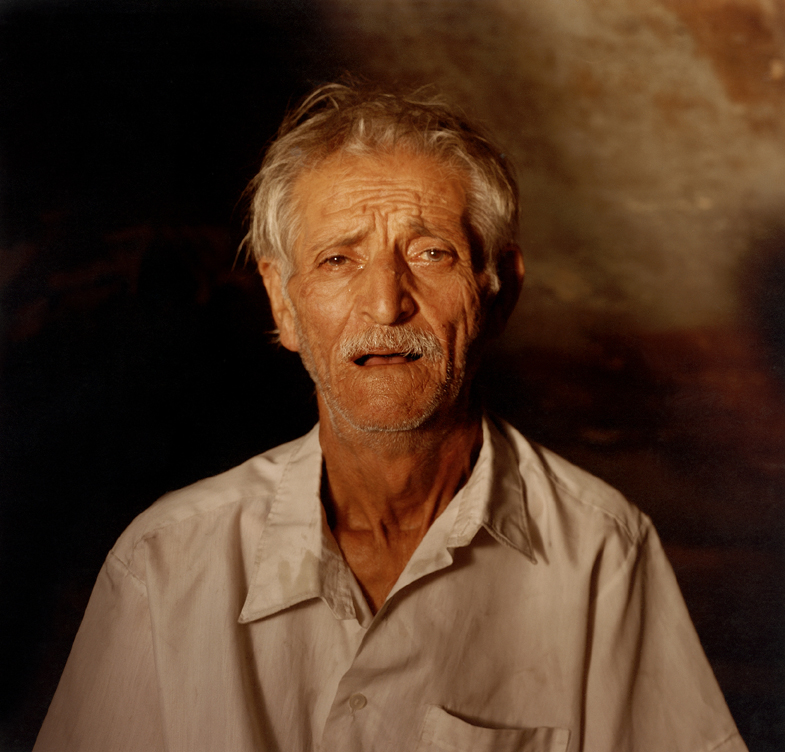
JULY/AUGUST 2006 WWW.TIKKUN.ORG
Israel / Palestine
Portrait of the Artist as Political Philosopher
Adi Nes
By Joel Schalit
THE MAIN ISSUE IN MY ART AND IN MY WORK," says Adi Nes, "is the issue of identity: male identity and Israeli identity." Best known in the U.S. for his homoerotic photographs of Israeli soldiers and in Europe for a series on designer clothes-wearing prison inmates commissioned by Vogue Hommes, since the
late 1990s Nes has become regarded as the face of modern Israeli photography. A queer Jew of Iranian descent who grew up in southern Israel, Nes' carefully staged photos are an art critic's dream come true. Politically charged, theoretically informed, contending with the intersection of gender, class, religion and nationality, Nes' work resonates with an absolutely heartfelt and intuitive understanding of the universal political questions raised by the complexities of Israeli culture.

Above: Job,2005,40x40
inches, color print.
"Three years ago, my father passed away from lung cancer. I remember his face during his last moments, fighting for every breath. In This image, I created a portrait of Job, but what I had in mind was my father—so I had my uncle pose for me."
Visiting San Francisco for the Contemporary Jewish Museum's April opening of the
Art of Living: Contemporary Photography from the Israel Museum, Jerusalem Exhibition (ongoing thru July 30th), Nes and I sat down for coffee to discuss his latest series of photographs, this time dealing with a subject of increasing interest to Jews worldwide: Israel's rising levels of social inequality. "In the new series," Nes begins, "I deal with people whose identity is being erased by society, by economic, and social (forms) of integration taking place both in Israel and all over the world."
However, as straightforward as Nes' explanation of his new work sounds, there's more to it than that. Framing his photographic treatment of Israeli inequality are the stories of the Prophets, Abraham and Isaac, the artistic influences of medieval Italian painter Caravaggio and American sculptor Duane Hanson.
"One layer (of the series) is the Bible, and on the other hand I pay tribute to Caravaggio," he explains. "Caravaggio made (Abraham and Isaac) into heroes, so I looked for a face very similar to Caravaggio s Abraham. But as long as it's the actual situation in Israel, it's not just the old masters. It's Duane Hanson s very famous sculpture, Supermarket Shopper as well. You can see my tribute to this in the picture of a man who is collecting bottles for recycling."
Adi Nes's work first appeared in Tikkun's November/December 2004 issue, accom-panied by captions written by San Francisco poet Daphne Gottlieb. In this second installment of his work, we showcase three of Nes' newest photos accompanied by
commentary on them by the artist himself. For a full-length transcription of our interview with Nes, please visit our website, www.tikkun.org/nes.
Noah (left): "[As I did] with most of the pictures for the new series, I deal with the 'lower' part of the lives of Biblical heroes. Not the Noah who got down from the Ark and saved the world—but the drunk Noah, after God gave him the grape and he made it into wine."
Abraham and Isaac (above): "In this picture, you see a man who is collecting bottles for recycling. I was thinking about the recycling of myths, about how many people I know who sacrifice their boys to the army to fight for the country, to fight for ideals which no longer exist." •
Joel Schalit is Managing Editor of Tikkun. All work courtesy Jack Shainman Gallery, New York.
JULY/AUGUST 2006 WWW.TIKKUN.ORG